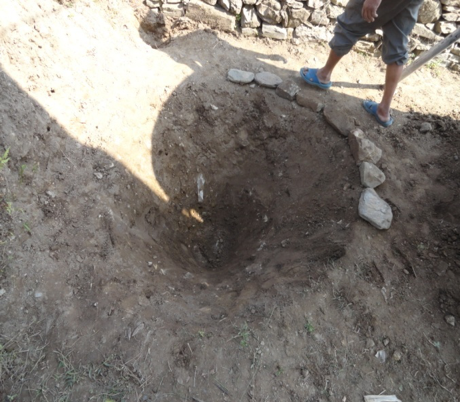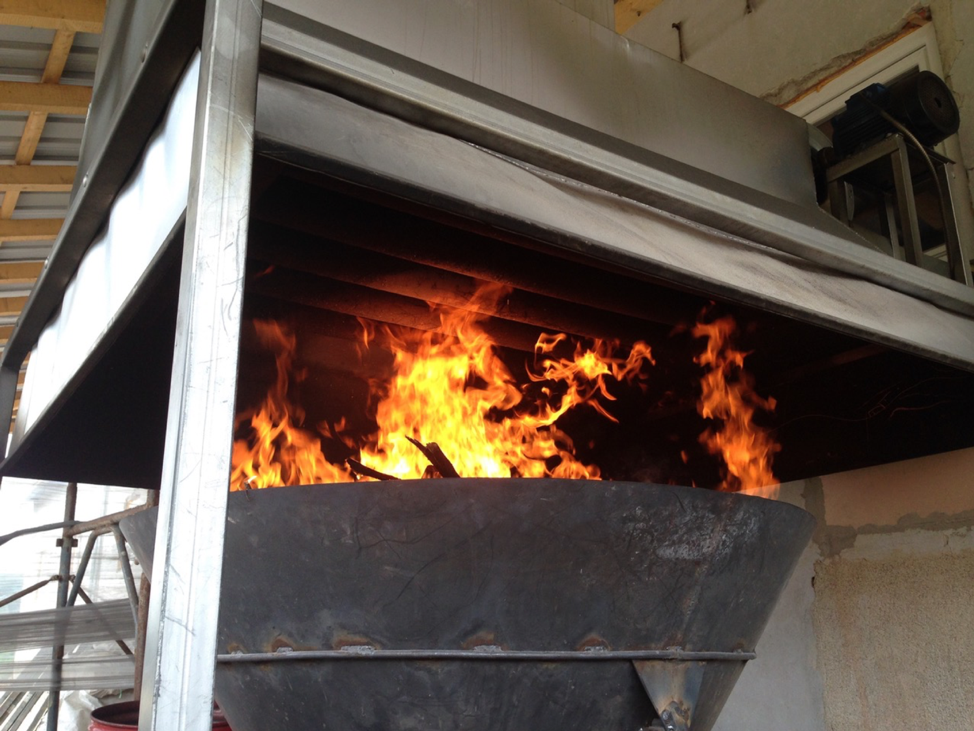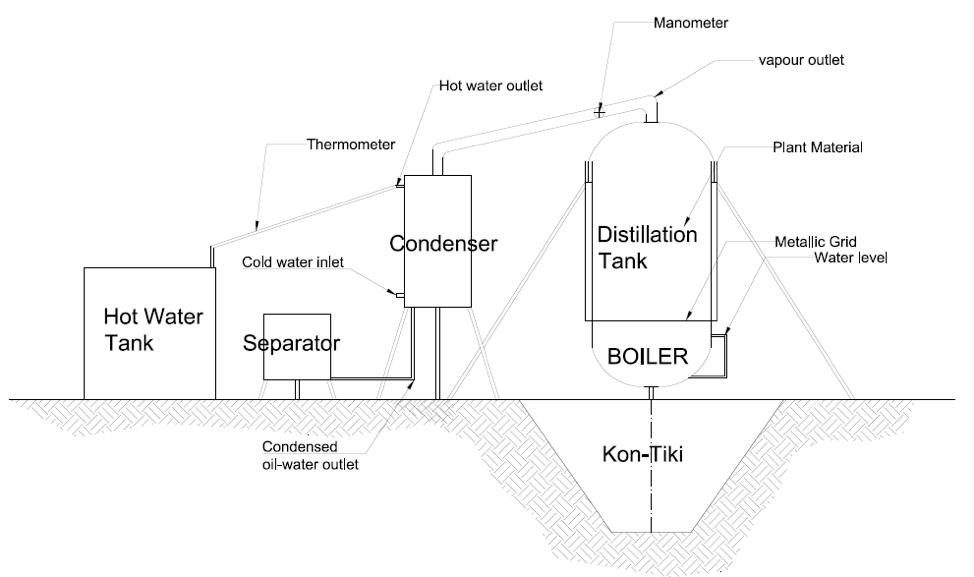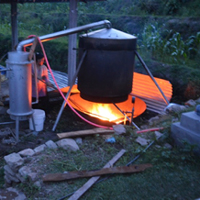Biochar production
Biochar is a promising new agricultural product with seemingly unlimited potential and range of uses. It offers a cascade of uses across many different fields, especially in agriculture and animal farming. The application of biochar based fertilizers is a quickly growing trend among farmers (Schmidt et al., 2017). Its use as a nutrient carrier has shown tremendous results in the yield of many different crops with a significant role in improving soil fertility and increasing crop production especially in tropical and subtropical agriculture ((Jeffery et al., 2017). It is also giving new hope as a climate change mitigation mechanism (Schmidt et al., 2018). Despite its immense potential, biochar only entered the real farm world when farmers were able to produce biochar on their farm with residues from their farm and thus avoid prohibitive costs of the nascent biochar industry (Schmidt & Taylor, 2014).
Biochar production in a Kon-Tiki is cheap and efficient. It only takes an hour or two to dig such a kiln in the soil (http://www.ithaka-institut.org/en/ct/111) or USD 500-2,000 to build a complete 1 m3 farm size version from steel (Schmidt & Taylor, 2014). When correctly fed with biomass (layer by layer under a consistent fire curtain), emissions of the Kon-Tiki biochar production are low (Cornelissen et al., 2016) at least compared to open fire and traditional char making techniques. However, only about 30-40% of the carbon of the initial biomass is conserved in the biochar while the remaining 60% is combusted in the fire above the kiln. This means that between ½ and 2/3 of the energy and carbon of the initial biomass is lost in the process. If this energy is not used replacing other fossil or biomass fuels, the process would be very inefficient from an energy and from a climate point of view.

Figure 1. Soil Pit Kon Tiki
Heat recovery of Kon-Tiki kilns
Standing for the first time besides a Kon-Tiki producing biochar is a memorable event as you literally feel the incredible energy released from the biomass. This same energy was originally provided by the sun, which upgraded atmospheric carbon (CO2) and water (H20) into the glucose – (CH2O)6 - based polymers of any organic matter (wood, bark, leaves, sugars, vitamins, tannins, phenols, etc.). When biomass is exposed to heat under the near absence of air (oxygen), most carbonaceous molecules of the biomass break apart which releases the chemical energy that was necessary to hold them together. From 350 to about 600°C this “breaking apart” energy is sufficient to drive the whole pyrolysis process on its own and is therefore called exothermic (it does not need external heat to continue the process). The carbonaceous molecules that break apart in the pyrolysis zone result either in solid carbon (biochar) or gaseous carbon (pyrolytic gas). While the solid part (biochar) remains in the kiln, the gaseous part is volatile and driven off due to the heat of the kiln into the air above the kiln. Those volatile pyrolytic carbons are mostly very reactive and burn when in contact with air which happens just above the Kon-Tiki kiln. When the Kon-Tiki is fully charged with pyrolyzing feedstock, several cubic meters of pyrolytic gas are released every minute consuming all available oxygen from the surrounding air which protects the below remaining solid carbon (biochar) from burning (reacting with the oxygen contained in the air).
The reaction of the volatile carbons (pyrolysis gas) with air above the kiln produces mostly CO2 as a chemical reaction product and a lot of thermal energy (heat). As nearly 2/3 of the energy initially contained in the biomass is released in the form of heat, not using this heat makes the Kon-Tiki a waste of energy.
A large portion of this energy released during the Kon-Tiki pyrolysis can be utilized by leveraging heat recovery devices for different purposes such as water heating, pasteurization, drying tea leaves, vegetables or fruits, and several other applications. These heat recovering devices are basically heat exchangers that transfer heat from the system at a higher temperature (gas temperature above the Kon-Tiki) to another system at a lower temperature (e.g. a water boiler) which can more easily be put to use.
The first heat recovery system for a Kon-Tiki kiln was developed by the Swiss engineer, Balz Bauer, who created a prospering biochar production facility in Serbia. As can be seen in the image below, he installed a water-driven heat exchanger within a wide exhaust collector. Such a recovery of thermal energy for space heating and warm water generation needs a rather regular production and use of the heat as it is difficult to store large amounts of hot water (one run of a 1 m3 Kon-Tiki heats easily 3000 l of water).

Fig. 2: Heat recovery over a Kon-Tiki developed by Balz Bauer.
In Nepal, where the farmers do not have enough feedstock to run the Kon-Tiki on a daily base and are not used to heating their houses even in winter, we explored the production of essential oils from local plant products using the heat released and recovered during biochar production. As described below, the heat recovery unit used above the Kon-Tiki was a distillation unit.
Essential Oil
An essential oil is a concentrated hydrophobic liquid containing volatile organic compounds from plants. It is "essential" in the sense that it contains the "essence of" the plant's fragrance—the characteristic fragrance of the plant from which it is derived. In contrast to fatty oils, essential oils typically evaporate completely without leaving a stain or residue.
Since ancient times, essential oils have been recognized as powerful plant products with a wide range of uses. They possess antioxidative and antimicrobial properties and can be used as natural food conservation additives as well as in active or smart packaging which effectively extends the shelf life of foods (Tongnuanchan & Benjakul, 2014). They are also known for their medicinal value, especially in the so called aromatherapy (Djilani & Dicko, 2012). Besides these, essential oils have been used as perfumes and flavoring of food agents for centuries.
In general, all parts of a plant contain essential oils. However, it depends on the plant species, which part of a plant delivers the most efficient quantities and highest qualities of oil from the extraction process, i.e. leaves, roots or rhizome, flowers, twigs, peels, seeds, bark, or buds (Tongnuanchan & Benjakul, 2014). For instance, leaves and bark of Cinnamon trees are generally used for essential oil production. The table below provides a series of examples for plants and plant parts that are commonly used for essential oil production.

Table 1: Parts of plants that can be used for essential oil extraction; Adaptation from Tongnuanchan & Benjakul (2014).
Method of extraction
While essential oil production becomes more and more industrialized, the selection of process parameters is still derived from a century-old craft. Selection of feedstock (plant material from which oil is extracted), drying of feedstock, heating rate, condensing rate and separation of condensed oil from water have to be carefully managed to ensure the quality of the oil.
Steam distillation is the most widely used extraction method (Aziz, 2018). Other processes include solvent extraction, expression, cold press extraction, and critical fluid extraction (Masango, 2005). In steam distillation, steamed water is passed through a packed bed of the plant materials located above the steam source. During this process, the aromatic compounds or essential oils from plant material are released. The water vapor is thus enriched with the plant oil and can subsequently be condensed and separated from the water.
Essential oil extraction coupled with biochar production
The schematic representation of the process of biochar production combined with the process of essential oil extraction is shown in Figure 2. The heat energy produced while making biochar is used for the production of steam from water that is forced through a tank filled with plant material, a process that is called steam distillation.
The distillation device is installed about 80 cm above the rim of the Kon-Tiki which leaves sufficient space to add biomass feedstock into the kiln and may pull enough air into the combustion zone to allow clean burning of the pyrolysis gases.
The distillation tank is first filled with water up to the metallic grid separating the upper part where the plant parts are tightly layered. Compaction is one of the most important procedures because if it is not well enough compacted, the steam would move up by forming tunnels without extracting the oil from the leaves. It is recommended that the leaves and other plant feedstock are pre-dried under the shade, rather than directly under the sun, to obtain a better yield quality.
Another crucial parameter in essential oil production is the temperature of steam. If the temperature is too low, the oil pockets of the leaves will not open and thus the oils will not be distilled. Too high temperatures risk damaging the essential oils or collecting unwanted, non-aromatic compounds. Temperatures required for optimal steam distillation typically fall between 60 °C and 100 °C which depends on the plants used for distillation and needs some testing. The boiler needs, therefore, to be equipped with thermocouples and the fire of the Kon-Tiki has to be adapted accordingly. Ideally, the pressure would also be controlled and should typically be within the range of 1.1 to 1.4 bar. However, pressure control makes the construction of the system more challenging.

Figure 2. Distillation unit combined with Kon Tiki for biochar as well as essential oil production
The steam rising through the plant layers gently evaporates the oil and carries it up to the vapor outlet. Once the steam pressure in the distillation tank is high enough, it is pushed through the vapor outlet to the condenser. The condenser has a spiraling water pipe inside where freshwater is pumped through to cool down the essential oil containing steam. The cold water flow rate is maintained in the condenser such that the temperature of the outlet water does not exceed 80°C. The water that is heated in the condenser is collected in a hot water tank from where it can be used for heating, pasteurization or hot showers. In fact, essential oil making days in Ratanpur, Nepal, are winter festival days for children enjoying one of the rare hot showers of the year.
The condensed oil-water then passes to an oil separator. As the oil is lighter than water, it floats on top of the condensed liquid and can easily be skimmed off. However, a small part of the oil will still be mixed with the condensed water which is called hydrosol. Hydrosol, also known as flower water, is nicely aromatic and has interesting properties for skincare, aromatherapy and also for cooking (people in Nepal like to cook the rice in cinnamon hydrosol).

Figure 3. Essential oil extraction through heat recovery method during biochar production
All parts of the distillation unit that might be in contact with the oil and vapor should be made from stainless steel, for all other parts mild steel is sufficient but should be dried and stored dry after the use.
Productivity of the Kon-Tiki distillation system
In Nepal, we tested the above-described distillation system with ambrosia plants and bamboo shoots but mostly with cinnamon leaves from the forest gardens that were planted beginning in 2015. Using 60 kg of shade-dried Cinnamon leaves produced 480 ml of essential Cinnamon oil in 4.5 hours. Besides the main product, one run produced 800 l biochar, 9-liter hydrosol, l50 l of cinnamon leaf marc, and 2150 l hot water (65° C). Alone the heating of the hot water (heated from 25° to 80 °C) correspond to an energy recovery of 100 kWh. It only needs one worker to run the oil and biochar production at this scale.
Conclusion
Producing essential oil with the waste heat of the Kon-Tiki is an excellent opportunity to improve the value of forest garden products. Selling only oil containing leaves to the market is not profitable considering the high volume of the feedstock that has to be carried backload by backload to the valley. However producing the oil close to the forest gardens, allows the creation of higher value products, which can then be bottled, labeled and marketed from the villages itself. However, it should be noted that shifting rural economies from pure agricultural tasks to the production of these products requires nurturing and developing the substantial mercantile talent of the local people to become entrepreneurs for refined products such as essential oil, silk, dried fruits, and other forest garden products.
While the establishment of lush, prospering forest gardens is rather straight forward and can be successfully realized over larger areas, to turn the harvestable forest garden products into sustainable income is more challenging and potentially limiting. Selling e.g. the essential cinnamon oil on the local wholesale market would generate only 50 Eur per liter hardly covering the costs of production. Creating a brand for climate positive essential oil from high biodiversity forest gardens with attractive labels, packaging and story would sell the product in Europe for more than 500 Eur per liter. However, few farmers have the knowledge and contacts to realize this. To obtain a fair income, they need reliable business development partners but they are as rare as water on a bare Himalaya hill, aren’t they?


Opportunity
This is such an interesting article and it makes my fantasy spin! Maybe I can make essential oil out of chipped pine wood that can in the next step be pyrolysed in the kon-tiki? Or from surplus apples that can afterward quickly become composted? Or from the giant kelp that we have just around the corner where I live at the moment?